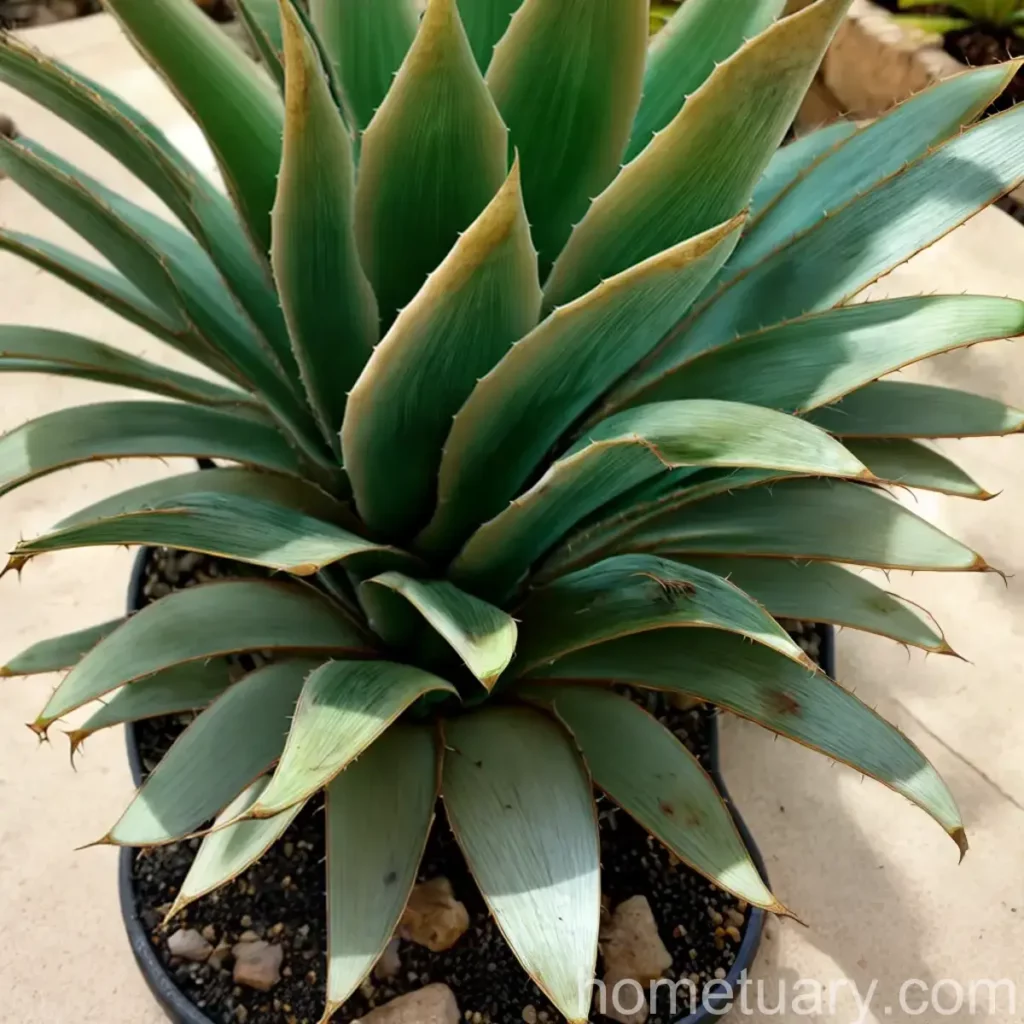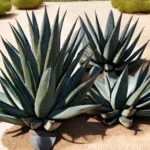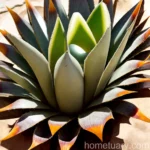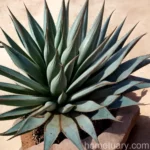Spineless Jade Agave (Agave Desmetiana): A Comprehensive Guide
Agave desmetiana, commonly known as spineless jade agave, is a striking and low-maintenance succulent plant that is popular for its ornamental value and versatility in landscaping. This comprehensive guide will provide you with in-depth knowledge about the culture, uses, propagation, care tips, common diseases, and much more related to spineless jade agave. Whether you are a seasoned horticulturist or just starting with gardening, this article is designed to cater to all levels of expertise.
What is Spineless Jade Agave (Agave Desmetiana)?
Spineless jade agave (Agave desmetiana) is an evergreen succulent plant belonging to the Asparagaceae family. Native to Mexico, it is widely cultivated for its attractive appearance and hardy nature. As the name suggests, it is characterized by its smooth, spineless leaves that are a vibrant shade of green, adding a touch of elegance to any garden or landscape.
This agave species is a relatively small to medium-sized plant, typically reaching a height and spread of 1 to 2 feet. Its compact rosette of leaves makes it a perfect choice for both indoor and outdoor cultivation. The unique architectural form and low maintenance requirements make it a sought-after plant for xeriscaping, rock gardens, and container gardening.
Key Takeaways – Spineless Jade Agave (Agave Desmetiana)
Before delving into the detailed aspects of spineless jade agave, let’s go through the key takeaways related to its culture, uses, and maintenance requirements.
- Culture:
- Native to Mexico
- Well-draining soil is essential
- Drought-tolerant once established
- Uses:
- Ornamental landscaping
- Container gardening
- Xeriscaping and rock gardens
- Water:
- Infrequent watering
- Allow soil to dry between waterings
- Sunlight:
- Full to partial sunlight
- Thrives in bright, indirect light
- Fertilizer:
- Minimal fertilization requirements
- Soil:
- Well-draining, gritty soil mix
- Pruning:
- Minimal pruning needed
- Remove dead or damaged leaves
- Propagation:
- Offsets
- Seeds
- Container Popularity:
- Well-suited for containers
- Common Diseases:
- Rot-related diseases
- Common Pests:
- Mealybugs
- Scale insects
Now, let’s explore each of these aspects in detail to gain a comprehensive understanding of spineless jade agave and how to care for it effectively.
Culture
Native Habitat
Spineless jade agave, or Agave desmetiana, is native to the mountainous regions of Mexico. It thrives in arid and semi-arid climates, where it is adapted to survive in harsh environmental conditions. The natural habitat of this agave species provides insights into its preferred growing conditions and offers valuable guidance for its cultivation in non-native environments.
Soil Requirements
One of the most critical factors for successfully growing spineless jade agave is the soil quality and composition. This succulent plant thrives in well-draining soil with a gritty texture. A cactus mix or a blend of sand, perlite, and loamy soil provides an ideal growing medium for agave desmetiana. The soil pH should be slightly acidic to neutral, ranging approximately between 6.0 and 7.0, to support optimal nutrient uptake and overall plant health.
Watering Needs
Being a succulent, spineless jade agave is adapted to store water in its fleshy leaves and can withstand periods of drought. Therefore, it is crucial to practice moderate and infrequent watering to prevent waterlogged conditions that can lead to root rot. Allow the soil to dry out completely between waterings, especially during the winter months when the plant’s growth slows down. Overwatering is a common mistake that can be detrimental to the health of agave desmetiana, so it is advisable to err on the side of underwatering rather than overwatering.
Sunlight Requirements
In its natural habitat, spineless jade agave is accustomed to receiving ample sunlight, making it well-suited for bright and sunny locations. When grown outdoors, it flourishes in full sunlight, tolerating the intense rays of the sun without adverse effects. However, it also adapts to partial sunlight and can thrive in bright, indirect light when cultivated indoors. Providing adequate sunlight is crucial for the plant’s growth and the development of its vibrant green foliage.
Uses
Ornamental Landscaping
The striking appearance of spineless jade agave makes it a popular choice for ornamental landscaping and garden design. Its compact size and architectural symmetry enable it to be used as an eye-catching focal point in rock gardens, succulent beds, and arid landscapes. Additionally, it complements other drought-tolerant plants and succulents, creating visually appealing and low-maintenance garden arrangements.
Container Gardening
Spineless jade agave finds extensive use in container gardening due to its compact growth habit and aesthetic appeal. When grown in containers, it adds a touch of exotic elegance to patios, balconies, and other outdoor living spaces. Its ability to thrive in pots and containers makes it an ideal choice for individuals with limited garden space or those looking to create a captivating display of succulents and cacti.
Xeriscaping and Rock Gardens
Xeriscaping, a landscaping practice that focuses on water conservation and the use of drought-tolerant plants, perfectly aligns with the characteristics of spineless jade agave. In xeriscape gardens and rock gardens, this agave species contributes to the creation of water-wise and environmentally sustainable landscapes. Its low water requirements and resilience to arid conditions make it an invaluable asset in regions facing water scarcity or water-use restrictions.
Water
The water needs of spineless jade agave are an essential aspect of its care, significantly impacting its overall health and vitality. Here are some specific guidelines related to watering this succulent plant:
-
Infrequent Watering: Spineless jade agave does not require frequent watering and is capable of withstanding periods of drought. Therefore, it is advisable to adopt a watering regimen that allows the soil to dry out between waterings, especially during the plant’s dormant or low-growth periods.
-
Soil Moisture Evaluation: Before watering, it is crucial to check the moisture level of the soil by inserting a finger into the growing medium. If the soil feels dry to the touch at a depth of 1 to 2 inches, it is an indication that the plant can be watered. Conversely, if the soil retains moisture, it is best to refrain from irrigating the plant to prevent root rot.
-
Avoid Overwatering: Overwatering is a common cause of issues in spineless jade agave, leading to root rot and other fungal infections. It is essential to exercise restraint when watering and allow the plant to endure mild to moderate drought periods, which mimic its natural environmental conditions.
Sunlight
Sunlight plays a pivotal role in the growth and development of spineless jade agave, influencing its overall vigor, leaf coloration, and flowering potential. Understanding the sunlight requirements of this succulent plant is essential for creating an environment that promotes healthy growth. Here are the key considerations related to sunlight exposure for agave desmetiana:
-
Full to Partial Sunlight: Spineless jade agave is well-adapted to thrive in full sunlight, receiving direct exposure to the sun for several hours each day. When cultivated outdoors, it performs optimally in locations that receive abundant sunlight, such as south-facing areas or open landscapes with minimal shade.
-
Indoor Sunlight: For indoor cultivation, it is advisable to position spineless jade agave in a well-lit area that receives bright, indirect sunlight. Placing the plant near a south or west-facing window can provide the adequate light levels it requires for sustained growth and robust foliage.
-
Sunlight Duration: The duration of sunlight exposure should be taken into account, ensuring that the plant receives approximately 6 to 8 hours of direct sunlight when grown outdoors. When positioned indoors, it benefits from exposure to natural light for similar durations or supplemented with grow lights to compensate for potential light deficits.
Fertilizer
Incorporating a well-balanced fertilization regimen is essential for promoting the healthy growth and development of spineless jade agave. However, it is important to exercise caution and avoid over-fertilizing, as this can have detrimental effects on the plant’s well-being. Here are the fundamental aspects of fertilizing agave desmetiana:
-
Minimal Fertilization Requirements: Spineless jade agave has modest fertilizer needs and can thrive without excessive nutritional supplementation. A controlled-release or liquid fertilizer specifically formulated for succulent plants can be applied sparingly during the growing season to provide essential nutrients.
-
Application Frequency: Fertilizer should be applied at a reduced frequency, generally once a month during the active growing period. Limiting the frequency of fertilization prevents the risk of nutrient buildup in the soil and averts the potential for fertilizer burn, which can harm the plant’s roots and foliage.
-
Dilution and Application Method: When applying fertilizer, it is advisable to dilute the concentrated solution to half or quarter strength to minimize the risk of overfeeding. The diluted fertilizer can be applied to the soil around the base of the plant, ensuring that it is absorbed by the roots during watering.
Soil
The selection of an appropriate soil mix is crucial for ensuring the optimal growth and well-being of spineless jade agave. The right soil composition provides the necessary drainage, aeration, and nutrient retention essential for the plant’s root system. Consider the following soil-related considerations when cultivating agave desmetiana:
-
Well-Draining Soil Mix: Spineless jade agave thrives in a well-draining soil mix that prevents water from pooling around the roots and promotes aeration of the growing medium. A cactus mix or a blend of coarse sand, perlite, and loamy soil creates an ideal soil environment for this succulent plant.
-
Gritty Texture: The soil should possess a gritty texture that facilitates rapid drainage and prevents the retention of excess moisture. A coarse and well-aerated soil mix reduces the risk of root rot and other moisture-related issues, ensuring the long-term health and vitality of the plant.
-
Soil pH: The optimal soil pH for spineless jade agave ranges from slightly acidic to neutral, approximately between 6.0 and 7.0. Maintaining an appropriate soil pH level supports the absorption of essential nutrients by the plant’s root system and contributes to overall physiological balance.
Pruning
Spineless jade agave generally requires minimal pruning, as it maintains its compact and symmetrical form without extensive intervention. However, occasional pruning may be necessary to remove dead or damaged leaves, maintain the plant’s shape, and promote overall tidiness. Here are some key considerations regarding pruning spineless jade agave:
-
Dead Leaf Removal: Periodically inspect the plant for dead or diseased leaves, which can be carefully trimmed away using sterilized pruning shears. Removing dead foliage enhances the plant’s appearance and mitigates the risk of fungal infections or pest infestations.
-
Minimal Intervention: It is important to exercise restraint when pruning spineless jade agave, as excessive trimming or cutting can disrupt the plant’s natural growth pattern and lead to physiological stress. Pruning should be limited to specific maintenance requirements, such as addressing damaged or unsightly foliage.
-
Pruning Technique: When conducting pruning activities, it is advisable to use clean and sharp pruning tools to ensure precise cuts and minimize the potential for tissue damage. Sterilizing the pruning equipment with alcohol or a disinfectant solution before and after use helps prevent the spread of diseases.
Propagation
Propagating spineless jade agave can be achieved through several methods, including offsets or pups and seed germination. By understanding the propagation techniques and requirements, individuals can expand their agave collection and share the plant’s beauty with others. Here are the primary propagation methods for agave desmetiana:
-
Offsets: Spineless jade agave produces offsets or pups around the base of the parent plant, which can be carefully separated and propagated into new individual plants. The offsets should be allowed to develop a callused surface before being placed in a well-draining soil mix to root and establish.
-
Seed Germination: Propagating spineless jade agave from seeds requires patience and careful attention to the germination process. Sowing agave desmetiana seeds in a suitable seed-starting mix and providing optimal temperature and moisture conditions can lead to the successful cultivation of new plants from seed.
-
Division: In some cases, mature spineless jade agave plants can be divided into smaller sections, each containing viable roots and shoots. Dividing the plant into segments allows for the propagation of multiple offspring, each capable of developing into independent plants with proper care.
Container Popularity
Spineless jade agave is highly favored for cultivation in containers due to its compact growth habit, striking appearance, and adaptability to potted environments. The plant’s container popularity stems from several key factors that make it an ideal choice for individuals seeking to incorporate succulents into their indoor or outdoor spaces:
-
Limited Space Requirements: Agave desmetiana’s modest size and slow growth make it well-suited for container gardening, especially in urban or confined settings where space is at a premium. Its ability to thrive in pots and containers enables individuals to enjoy the beauty of this succulent plant without extensive garden space.
-
Aesthetic Appeal: The architectural form and vibrant foliage of spineless jade agave make it an attractive addition to container displays, enhancing the visual appeal of patios, decks, and balconies. Its unique texture and coloration create a focal point in container arrangements and complement diverse plant combinations.
-
Portability: Potted spineless jade agave can be easily moved and repositioned according to seasonal light requirements, temperature fluctuations, or aesthetic preferences. The plant’s portability allows for flexible placement in different areas of the home or garden, accommodating its specific environmental needs.
Common Diseases
Spineless jade agave, like other succulent plants, is susceptible to certain diseases, especially those that are related to excessive moisture or poor growing conditions. Understanding the common diseases that can affect agave desmetiana is essential for implementing preventive measures and maintaining plant health. Here are the primary disease concerns associated with spineless jade agave:
-
Root Rot: Overwatering and poorly drained soil are common contributors to root rot in spineless jade agave. Prolonged exposure to excessively moist conditions can lead to the development of root rot, characterized by dark, mushy roots and a decline in overall plant vigor.
-
Leaf Spot: Fungal pathogens can cause leaf spot disease in spineless jade agave, resulting in the formation of discolored or necrotic spots on the foliage. Leaf spot is often associated with excessive moisture, high humidity, or inadequate air circulation, emphasizing the importance of proper watering and environmental management.
-
Pest-Related Issues: While not a disease in the traditional sense, pest infestations can significantly impact the health of spineless jade agave. Common pests, such as mealybugs and scale insects, can weaken the plant and interfere with its growth, necessitating prompt intervention and control measures.
Disease Diagnosis
Diagnosing and addressing diseases in spineless jade agave requires keen observation, proactive management, and timely intervention to prevent the spread of infections and minimize the impact on plant health. Conducting regular inspections and monitoring the plant’s condition are essential for detecting potential disease issues. Here are the key steps for disease diagnosis and management:
-
Visual Assessment: Thoroughly examine the plant for any signs of discoloration, wilting, or abnormal growth patterns. Look for symptoms such as dark or waterlogged roots, yellowing or browning of leaves, and the presence of lesions or spots on the foliage.
-
Root Inspection: Carefully inspect the roots for any indications of rot, decay, or fungal growth. Gently remove the plant from its pot to assess the root system and identify any anomalies that may be indicative of root rot or other soil-borne diseases.
-
Environmental Review: Evaluate the growing conditions, including watering practices, sunlight exposure, and humidity levels, to identify any factors contributing to disease development. Adjusting the environmental parameters can help mitigate disease progression and create a more favorable growing environment for the plant.
-
Prompt Action: If disease symptoms are observed, take prompt action to isolate the affected plant, improve growing conditions, and implement appropriate treatment measures. This may involve adjusting the watering regimen, applying fungicidal treatments, or addressing the underlying factors contributing to disease susceptibility.
Common Pests
In addition to disease concerns, spineless jade agave is vulnerable to infestations by certain pests that can compromise its health and vitality. The presence of pests, if left unaddressed, can lead to significant damage to the plant and necessitate remedial actions to mitigate their impact. Here are the primary pest-related issues associated with agave desmetiana:
-
Mealybugs: Mealybugs are common sap-feeding pests that infest the foliage, stems, and leaf axils of spineless jade agave. These small, white, cottony insects can weaken the plant and cause leaf distortion, yellowing, and the secretion of honeydew, leading to the growth of sooty mold.
-
Scale Insects: Scale insects, including armored and soft scale varieties, can attach themselves to the leaves and stems of spineless jade agave, siphoning nutrients from the plant and potentially causing stress and decline. The presence of scale insects is often indicated by the formation of raised, waxy coverings on the plant’s surface.
Botanist’s Tips
As a botanist specializing in succulent plants, I have cultivated and studied spineless jade agave extensively, gaining valuable insights into its growth requirements and care practices. Drawing from my expertise, I offer the following botanist’s tips for successfully cultivating and maintaining agave desmetiana:
-
Optimal Light Exposure: Provide spineless jade agave with ample sunlight, both indoors and outdoors, to support robust growth and vibrant foliage coloration. Position the plant in a location that receives direct sunlight for several hours each day while ensuring protection from intense midday sun during the hottest months.
-
Adequate Air Circulation: Enhance air circulation around spineless jade agave by spacing plants appropriately and avoiding overcrowding. Good air movement helps prevent the development of fungal diseases, aids in transpiration, and reduces the risk of pest infestations.
-
Consistent Monitoring: Regularly monitor the plant for changes in its appearance, including leaf coloration, texture, and overall health. Timely attention to any abnormalities or disease symptoms enables proactive intervention and prevents issues from escalating.
-
Seasonal Adjustments: Adapt the care routine for spineless jade agave according to seasonal changes, such as adjusting watering frequency during the winter months and providing supplemental light for indoor plants during periods of reduced sunlight.
-
Selecting Companion Plants: When incorporating spineless jade agave into garden designs, consider companion plants that share similar environmental requirements and complement its aesthetic characteristics. Drought-tolerant succulents, agaves, and ornamental grasses make excellent companions for agave desmetiana in landscaping arrangements.
Fun Facts
To enrich your knowledge and appreciation of spineless jade agave, here are some intriguing fun facts about















